Bitcoin L2s 101
 cryptobriefing.com 31 July 2024 22:04, UTC
cryptobriefing.com 31 July 2024 22:04, UTC Bitcoin Layer 2 solutions are built on top of the main Bitcoin network to address its limitations:
- Speed up transactions
- Lower fees
- Enable more features and apps
Key Layer 2 solutions:
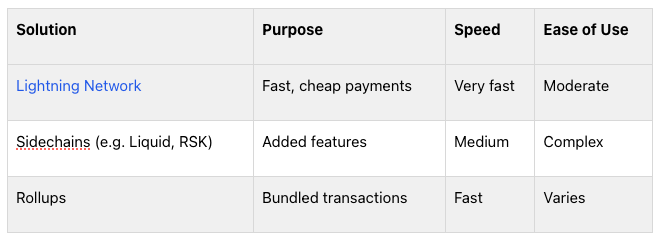
Benefits:
- Process more transactions per second
- Reduce congestion on main Bitcoin network
- Enable smart contracts and DeFi on Bitcoin
Challenges:
- Some solutions are centralized
- Can be complex for users
- Security and interoperability concerns
As Layer 2 solutions evolve, they aim to make Bitcoin faster, cheaper, and more versatile for everyday use while maintaining its core principles.
Bitcoin‘s Main Problems
Slow Transactions
Bitcoin has limits on how fast it can process transactions:
- About 5 transactions per second
- Block size: 1-4 MB (usually around 2 MB)
- Block time: 10 minutes
These limits help:
- Keep the blockchain from growing too big
- Stop spam attacks
But they also cause problems for users.
Long Wait Times and Small Blocks

Users often have to wait a long time for their transactions to go through.
Network Jams and High Fees
When lots of people use Bitcoin at once:
- Transactions pile up
- Network gets slow
- Fees go up

This makes Bitcoin expensive to use when it’s busy.
Basics of Bitcoin Layer 2 Solutions
What They Are
Bitcoin Layer 2 solutions are extra systems built on top of the main Bitcoin network. They help Bitcoin work better and handle more transactions.
How They Work
Layer 2 solutions move some transactions off the main Bitcoin network. This helps:
- Reduce network traffic
- Speed up transactions
- Lower fees
These solutions use special contracts to keep transactions safe. They then send the final results back to the main Bitcoin network.
Main Advantages
Layer 2 solutions offer three key benefits:
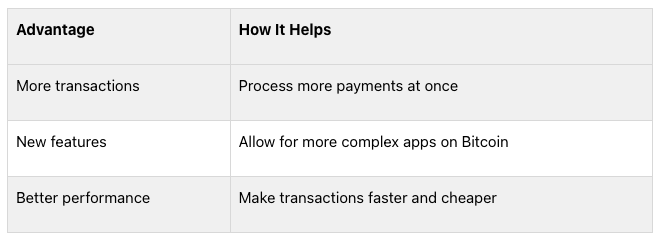
Make transactions faster and cheaper
These improvements help Bitcoin handle more users and different types of apps without changing its core system.
Types of Layer 2 Solutions
State Channels
State channels are Layer 2 solutions that let two parties make many transactions without recording each one on the Bitcoin blockchain. They work by:
- Creating a private channel between two users
- Allowing fast, cheap transactions off the main chain
- Only recording the start and end of the channel on Bitcoin
Benefits and drawbacks of state channels:

Sidechains
Sidechains are separate blockchains connected to Bitcoin. They allow:
- Moving assets between Bitcoin and the sidechain
- Running different types of apps and features
- Faster and more private transactions
How sidechains work:
- Convert Bitcoin to sidechain tokens
- Use tokens on the sidechain
- Convert tokens back to Bitcoin when needed
Examples of Bitcoin sidechains:

Rollups
Rollups bundle many transactions together before putting them on the Bitcoin blockchain. This helps:
- Process more transactions
- Lower fees
- Keep the main chain less crowded
Types of rollups:

Rollups are new and still being tested. They could make Bitcoin handle more transactions, but they also have some problems to solve.
Focus on the Lightning Network

How It Works
The Lightning Network is a Layer 2 system that helps Bitcoin handle small payments quickly and cheaply. It works by:
- Creating payment channels between users
- Moving transactions off the main Bitcoin network
- Using smart contracts to keep payments safe
Here’s a simple breakdown of how it works:
1. Open a payment channel with another user 2. Make many fast, cheap transactions through the channel 3. Close the channel and record the final balance on the Bitcoin network
Uses and Benefits
The Lightning Network offers several key benefits:
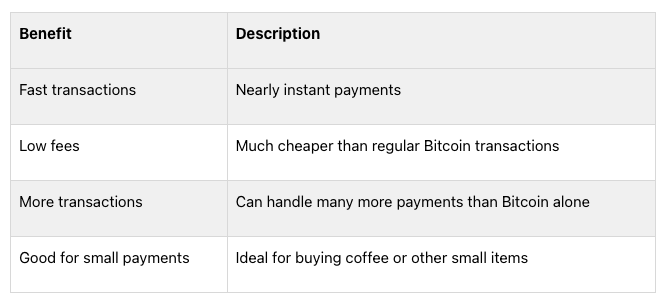
Current Use and Future Growth
The Lightning Network is the oldest and most used Bitcoin Layer 2 system. Here are some key facts:
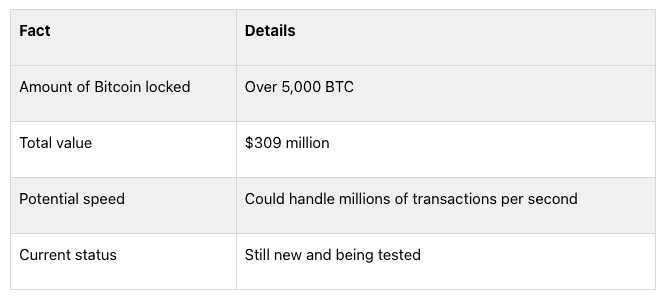
While the Lightning Network is helpful, it’s not perfect:
- Not good for large payments
- Channels can close unexpectedly
- Users need to move Bitcoin in and out of channels often
Despite these issues, the Lightning Network is making Bitcoin faster and cheaper to use. It’s helping Bitcoin grow and could lead to new services in the future.
Understanding Sidechains
Liquid Network: Key Points

The Liquid Network is a sidechain that helps make Bitcoin transactions faster and more private. It’s useful for exchanges and traders who need quick, secret transfers. Here’s what you need to know:
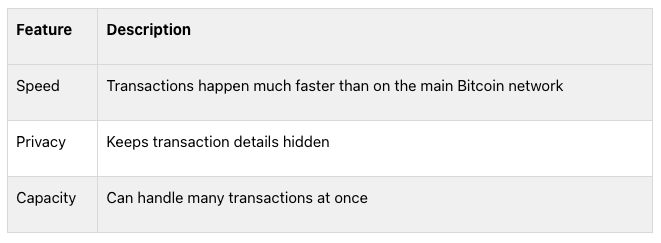
Rootstock (RSK): Smart Contracts

Rootstock (RSK) is a sidechain that adds smart contracts to Bitcoin. This lets people build apps and complex money tools on Bitcoin. Here’s what RSK does:
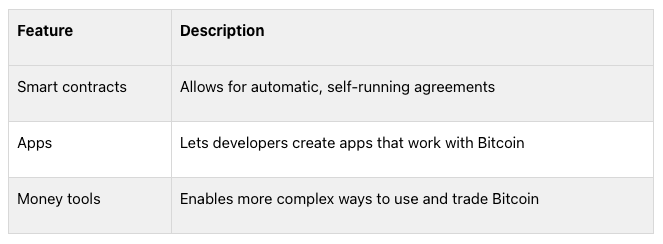
Comparing Sidechain Types
Different sidechains do different things. Here’s a simple comparison:

Rollups for Bitcoin
How Rollups Work
Rollups help Bitcoin handle more transactions by:
- Collecting many transactions
- Processing them off the main Bitcoin network
- Sending a summary back to Bitcoin
This makes Bitcoin faster and cheaper to use.
Here’s how rollups work step-by-step:
- Gather transactions
- Process them separately
- Send a batch to Bitcoin
- Bitcoin checks the batch
Two Types of Rollups
There are two main kinds of rollups:

Optimistic Rollups
- Assume transactions are correct
- Only check if someone reports a problem
- Faster but might have errors
Zero-Knowledge Rollups
- Use math to prove transactions are correct
- Keep information private
- Slower but safer
How Rollups Help Bitcoin Speed
Rollups make Bitcoin faster by:
- Handling more transactions at once
- Reducing traffic on the main Bitcoin network
- Lowering fees
This helps Bitcoin work better for everyday use.

Rollups are new and still being tested. They could help Bitcoin grow, but there’s still work to do to make them perfect.
Layer 2 Solutions Side-by-Side
Comparison Chart
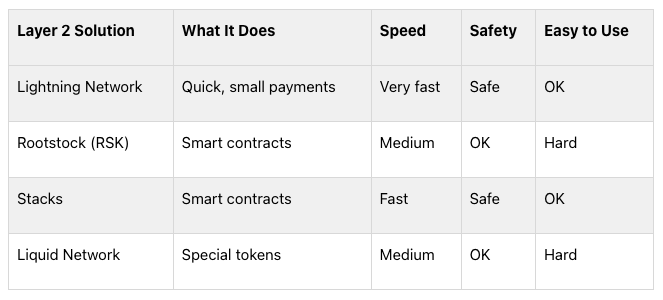
Good and Bad Points
Good:
- Faster: Layer 2 solutions can handle more payments at once, making Bitcoin less crowded.
- Safer: Many Layer 2 options have extra safety features to protect users’ money.
- Easier: Some Layer 2 solutions, like Lightning Network, are simpler to use than regular Bitcoin.
Bad:
- Less Spread Out: Some Layer 2 options, like Liquid Network, rely on a few big companies, which goes against Bitcoin’s idea of being spread out.
- Hard to Understand: Some Layer 2 solutions, like Rootstock, are tough for regular people to use and get.
- Don’t Always Work Together: Different Layer 2 solutions might not work well with each other, which limits how useful they can be.
Problems with Layer 2
Safety Issues
Layer 2 solutions for Bitcoin can have some safety problems:
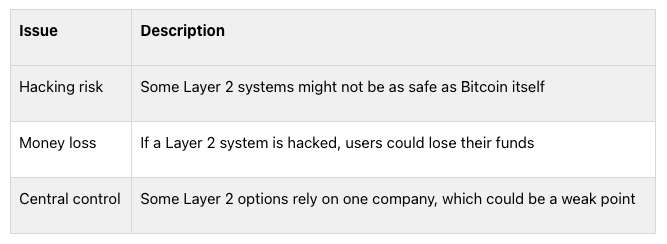
Centralization Concerns
Some Layer 2 solutions go against Bitcoin’s idea of being spread out:

Hard to Use
Layer 2 solutions can be tough for new users:
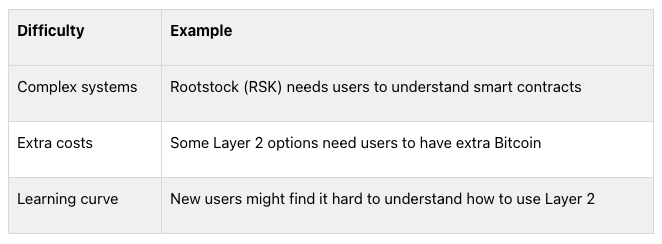
While Layer 2 solutions help Bitcoin in many ways, they also bring new problems. As these systems grow, we’ll likely see new ideas that try to fix these issues and make things easier for users.
What’s Next for Bitcoin Layer 2
New Projects Coming Soon
Bitcoin Layer 2 is always changing, with new ideas popping up often. Here are some things to look out for:
- Rollups: These are getting better at making Bitcoin faster and cheaper to use.
- DeFi on Bitcoin: Layer 2 solutions like Lightning Network and Stacks are helping create new money services on Bitcoin.
How It Might Change Bitcoin
Layer 2 solutions could make big changes to Bitcoin:
- More people might start using Bitcoin
- New ways to use Bitcoin could appear
- Bitcoin could become part of a new kind of money system
Connecting with DeFi and Other Tech
Bitcoin Layer 2 is starting to work with other tech:
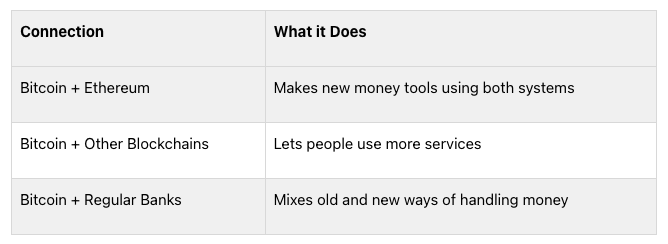
As Bitcoin Layer 2 grows, we’ll likely see more new ideas and ways to use it. Bitcoin’s focus on being safe and open to everyone makes it a good fit for these new money systems.
Wrap-Up
Key Points to Remember
Bitcoin Layer 2 solutions help fix Bitcoin’s problems with handling many transactions. They:
- Process transactions off the main Bitcoin network
- Make transactions faster and cheaper
- Allow for new apps and services on Bitcoin
Some popular Layer 2 solutions include:
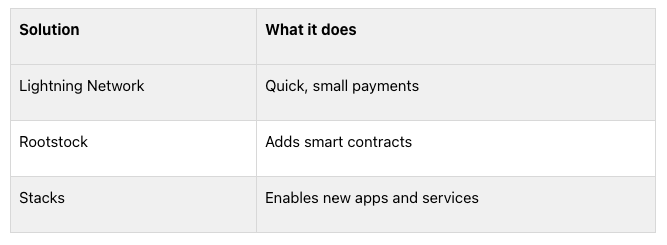
Layer 2’s Role in Bitcoin’s Future
Layer 2 solutions are important for Bitcoin’s growth. They help Bitcoin:
- Handle more transactions
- Work better for everyday use
- Support new types of apps and services
As more people use Layer 2 solutions, we can expect:
- More people using Bitcoin
- New ways to use Bitcoin
- Bitcoin becoming part of newer money systems
These changes could make Bitcoin more useful and popular in the future.




